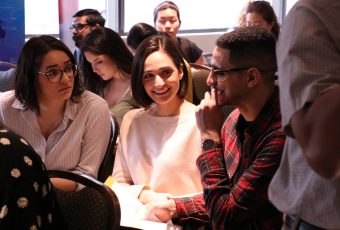Melbourne debunks the sixth sense
New research led by the University of Melbourne has helped debunk the common belief that a sixth sense, also known as extrasensory perception (ESP), exists.

The study, published recently in the journal PLOS ONE, found that people could reliably sense when a change had occurred, even when they could not see exactly what had changed.
For example, a person might notice a general change in someone’s appearance but not be able to identify that the person had had a haircut.
Lead researcher Dr. Piers Howe from the Melbourne School of Psychological Sciences said the research is the first to show in a scientific study that people can reliably sense changes that they cannot visually identify.
“There is a common belief that observers can experience changes directly with their mind, without needing to rely on the traditional physical senses such as vision, hearing, taste, smell and touch to identify it. This alleged ability is sometimes referred to as a sixth sense or ESP,” he said.
The University of Melbourne psychology researchers were able to show that while observers could reliably sense changes that they could not visually identify, this ability was not due to extrasensory perception or a sixth sense.
In the study, observers were presented with pairs of colour photographs, both of the same female. In some cases, her appearance would be different in the two photographs. For example, the individual might have a different hairstyle.
Each photograph was presented for 1.5 seconds with a 1 second break between them. After the last photograph, the observer was asked whether a change had occurred and, if so, identify the change from a list of nine possible changes.
Results showed study participants could generally detect when a change had occurred even when they could not identify exactly what had changed. For example, they might notice that the two photographs had different amounts of red or green but not be able to use this information to determine that the person had changed the colour of their hat.
This resulted in the observer “feeling” or “sensing” that a change had occurred without being able to visually identify the change. Thus, the result that observers can reliably feel or sense when a change has occurred without being able to visually identify the change could be explained without invoking an extrasensory mechanism.
The research was led by Senior Lecturer Dr. Piers Howe in collaboration with researcher Margaret Webb at the Melbourne School of Psychological Sciences, University of Melbourne.
Melbourne School of Psychological Sciences
The school in its current structure was established in 2012, when the The Faculty of Medicine, Dentistry and Health Sciences announced the creation of its fifth school: the Melbourne School of Psychological Sciences (MSPS).
Formerly known as the School of Behavioural Science, and subsequently as the Psychological Sciences Academic Centre within the Melbourne Medical School, the school is home to a vibrant community of more than 70 academic, teaching, research and professional staff, 100 honorary staff and 150 PhD students.
In Australia, psychology is taught at the university level and entry is extremely competitive. To be able to register to work as a psychologist in Australia, graduates must complete a four-year/Honours degree, followed by two years of either study in a specialist area or supervised practice. OzTREKK’s Australian universities offer professional training via Master’s and Doctor of Psychology degrees. The programs comprise professionally oriented coursework, supervised practical training and major research dissertation.
*
Would you like more information about studying psychology at the University of Melbourne? Contact OzTREKK Admission Officer Rachel Brady at rachel@oztrekk.com or call toll free in Canada at 1 866-698-7355 for more information about psychology degrees available at Australian universities.

































Ask A Question
Ask us about your program of interest, or if you have a question about our services.
CONTACT US TODAY